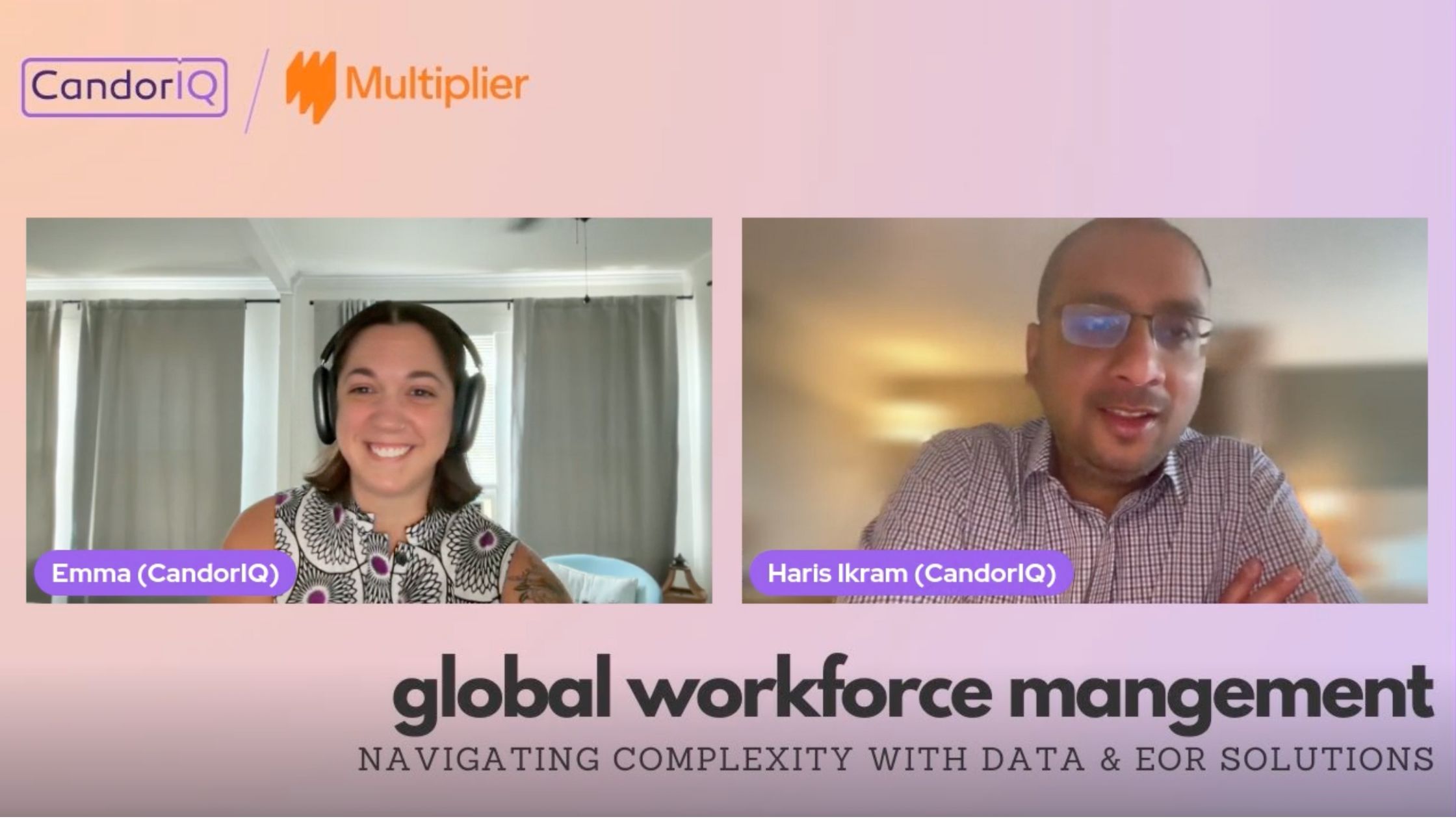Recap: Global Workforce Management Webinar with Haris Ikram, Co-Founder and CEO of CandorIQ
Learn how to navigate global workforce complexities with data and EOR insights from CandorIQ’s CEO

In a recent webinar—Global Workforce Management: Navigating Complexities with Data & EOR Solutions—I shared some insights on global workforce planning, drawing from my personal and professional experiences.
This topic is particularly relevant to me for a couple reasons. First, as an immigrant who’s worked in multiple countries and continents, I’ve experienced some of the challenges firsthand. Second, as a people manager of global teams and now as a founder of a global HR tool, I’ve witnessed the evolving landscape of the “modern workplace.” global work. In the last few years specifically, it rarely ever seems to be one place at all.
You can view the full conversation here, but I’ll share a recap below.
Why Is There More Talk About a Global Workforce?
The pandemic fundamentally reshaped how we think about work. Companies were forced to adapt to remote operations, and in doing so, discovered the benefits of casting a wider net to hire top talent across borders. Even as the world has adjusted post-pandemic, many companies have chosen to maintain their global hiring practices because the infrastructure to support remote work has become stronger than ever.
From improved tech tools that facilitate communication and meetings to better understanding how to build a global company, these once-niche practices are no longer Silicon Valley secrets. The knowledge has spread, and more companies are embracing the opportunity to scale globally.
Benefits of a Global Workforce
There are several key advantages of expanding your workforce globally:
- Access to top talent – A global talent pool enables you to hire the best individuals who fit your company’s needs, regardless of their location.
- Cost-efficiency – It can be more economical to hire in regions where compensation levels vary.
- Time zone flexibility – Having employees in different time zones allows your company to better serve clients around the clock.
- Diversity of perspectives – A global team brings a variety of cultural and professional backgrounds, fostering innovation and new ideas.
Trends and Challenges in Managing a Global Workforce
More than half of CandorIQ's customers are global, and one of the most prominent trends is the growing need for comprehensive global data and systems. We’ve responded to this need with a data set that encompasses over 10 million records, helping companies manage their global workforce more effectively.
A few other challenges that are worth considering (and that our team works hard to answer):
- Integration issues – Global systems, such as HRIS platforms, don't always integrate seamlessly across different regions. some text
- CandorIQ integrates with 120+ HR systems, pulling all the information you need into one platform.
- Limited global visibility – Getting a unified view of your workforce can be difficult, complicating headcount planning and budgeting.some text
- With headcount planning tools like our Scenario Planning, you can see how changes in one geo might impact your global budget.
- Cultural nuances – Different countries have unique cultural expectations that need to be factored into workforce planning.some text
- With features like our Total Rewards Portal, you can inform and educate your employees about their compensation and benefits; providing clarity around regional pay philosophy differences.
How HR Tech Can Address These Challenges
Planning early is crucial. I recommend thinking through cost implications and assessing if the right skills are available in the right markets before scaling globally. I an’t over emphasize the importance of headcount planning and considering how workforce distribution affects organizational design.
An Employer of Record (EOR) solution, like Multiplier, can alleviate legal and compliance burdens, making it easier to navigate employment laws in various regions. Meanwhile, tools like CandorIQ offer global benchmarking data (we specifically have data for 100+ countries), the ability to plan in local currencies, provide total rewards visibility, and more. In turn, these tools help with retention and building organizational trust.
My Top 3 Considerations When Planning a Global Team
To effectively build and manage a global workforce, I’d start with these three critical steps:
- Define your purpose – Why are you expanding globally, and how does it align with your business goals?
- Infrastructure planning – What systems and tools will you need to support your global team?
- Cultural considerations – Understand the local culture and ensure your expansion feels connected to your company’s HQ by having a landing team that bridges the gap.
It’s easier than ever to have a global workforce, but the decision to expand comes with complexities. Careful planning, cultural awareness, and the right tools—like CandorIQ and Multiplier—can help businesses navigate these challenges and unlock the many benefits of a global team.
Let me know if you want to learn more about how we can help ease the burden of your global workforce planning. Schedule a demo today.


